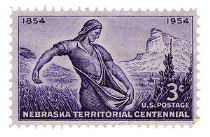Extension, Cooperative

Nebraska Agricultural Experiment Station: Historical Research Bulletins
Date of this Version
6-1938
Document Type
Article
Citation
Hathaway, I.L., Davis, H.P. and Brauer, J.C. (1938) The vitamin A content of soybean silage and of A.I.V., molasses, and common corn silages, and the effect of feeding these materials upon the vitamin A content of milk (Research Bulletin: Bulletin of the Agricultural Experiment Station of Nebraska No. 101)
Abstract
A study was made of the vitamin A content of soybean silage, and of A.l.V., molasses, and common corn silage. The silages were fed to groups of cows and the vitamin A content of their milk determined. The vitamin A determinations were made by feeding the silage or the milk to groups of rats whose body stores of this vitamin had been depleted by being fed a vitamin-A-deficient ration. Approximately 780 rats were used in these experiments. There were no apparent ill effects of feeding as much as 3.2 grams of the A.l.V. silage per rat per day for eight weeks. This was 20 to 30 per cent of the food consumed. The A. l.V. silage contained only slightly more vitamin A than did the molasses silage. The ordinary corn silage contained less vitamin A than either the A.I.V. or molasses silage. The soybean silage was inferior to any of the other silages as a source of vitamin A. Milk produced by cows receiving these silages as the only source of roughage ranked in the same order of vitamin A potency as did the silages, namely A.I.V. silage, molasses silage, and common silage. On the other hand when a good g ade of alfalfa hay served as the only source of roughage, the milk produced contained more vitamin A than did the milk produced by cows receiving A.I.V. silage as the only roughage. In another experiment one group of cows was fed both molasses silage and alfalfa hay, while a second group received A.I.V. silage and alfalfa hay. The hay was fed ad libitum and the group which received the molasses silage consumed the most hay. In this instance the milk produced by the group receiving the molasses silage contained more vitamin A than did the milk produced by the A.l.V. silage group, which was probably due to the greater consumption of alfalfa hay.
Included in
Agriculture Commons, Dairy Science Commons, Nutrition Commons


Comments
ISSN 0097-1432